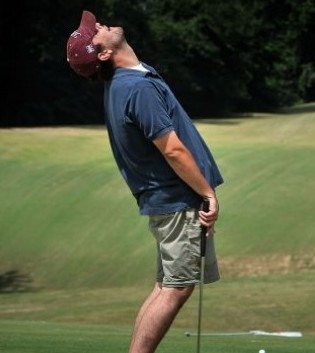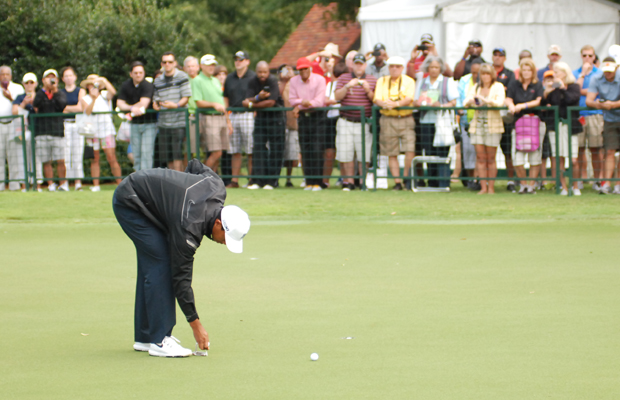Opinion & Analysis
Why do golf’s ruling bodies keep making the game more difficult?

Golf is one of the most difficult games on the planet. So why is it that golf’s ruling bodies, the USGA and R&A, continue to establish new rules that make the game more difficult?
The argument is often made that we need to protect the integrity of the game. If that is the case, we need to all immediately go back to using all wooden clubs and feathery golf balls. And let’s go back to letting sheep maintain our golf courses, too.
Innovation is good for the game. Lower scores are more entertaining at the professional level, and much more fun for the amateur golfer. They bring more fans, more revenue, more players and a generally healthier industry.
Let’s look at the last three major decisions with respect to the rules of golf:
- Limiting the spring-like effect (COR) of drivers
Limiting the coefficient of restitution (COR) in a driver limits the distance that golfers will hit a golf ball. Longer drives bring crowds to PGA Tour events. Bubba Watson is one of the hottest players on the PGA Tour and John Daly is still popular for this very reason. Amateur players benefit from hitting shorter clubs into every hole with a hotter driver.
- Dulling grooves in wedges and irons
Controlling a groove’s volume and sharpness limits the amount of backspin that can be generated, particularly out of lies in the rough. This will lessen the ability of golfers to hold greens, and depending on conditions it can lead to higher scores — players will have to either pitch or chip instead of putt.
Again, lower scores lead to a more entertaining product and less enjoyment at the amateur level. If you look at scoring at the highest level, one could argue that this ruling really hasn’t affected touring pros – if it has, the changes are minimal. Amateur golfers were the one who lost in this scenario, especially the ones who like to play by the same rules as the pros and were forced to buy new wedges.
- Anchoring of the putter
Anchoring the putter will allow some players to get more enjoyment out of the game, and for some it will allow them to play at a higher level. Some use the technique to escape the yips, while others use anchoring for health reasons. Regardless of why a player decides to use an anchoring technique, it will immediately make the game more difficult for some by not allowing all to give the technique a try.
The bottom line is that the governing bodies should not be focusing on making the game more difficult for the less than 1 percent of the golfing population that make a living playing the game. They should allow innovation to make the game more fun for us all. Making the game more fun for most of us will also allow for a more entertaining product with lower scores. If you want to protect par in your championships, don’t make the game more difficult by changing the rules and stifling innovation. Make the rough higher, the fairways narrower and greens smaller in your course setups. Yes, I’m talking to you Mike Davis.
Click here for more discussion in the “Golf Talk” forum.
- LIKE1
- LEGIT0
- WOW0
- LOL0
- IDHT0
- FLOP1
- OB0
- SHANK0
19th Hole
Vincenzi’s 2024 Zurich Classic of New Orleans betting preview

The PGA TOUR heads to New Orleans to play the 2023 Zurich Classic of New Orleans. In a welcome change from the usual stroke play, the Zurich Classic is a team event. On Thursday and Saturday, the teams play best ball, and on Friday and Sunday the teams play alternate shot.
TPC Louisiana is a par 72 that measures 7,425 yards. The course features some short par 4s and plenty of water and bunkers, which makes for a lot of exciting risk/reward scenarios for competitors. Pete Dye designed the course in 2004 specifically for the Zurich Classic, although the event didn’t make its debut until 2007 because of Hurricane Katrina.
Coming off of the Masters and a signature event in consecutive weeks, the field this week is a step down, and understandably so. Many of the world’s top players will be using this time to rest after a busy stretch.
However, there are some interesting teams this season with some stars making surprise appearances in the team event. Some notable teams include Patrick Cantlay and Xander Schauffele, Rory McIlroy and Shane Lowry, Collin Morikawa and Kurt Kitayama, Will Zalatoris and Sahith Theegala as well as a few Canadian teams, Nick Taylor and Adam Hadwin and Taylor Pendrith and Corey Conners.
Past Winners at TPC Louisiana
- 2023: Riley/Hardy (-30)
- 2022: Cantlay/Schauffele (-29)
- 2021: Leishman/Smith (-20)
- 2019: Palmer/Rahm (-26)
- 2018: Horschel/Piercy (-22)
- 2017: Blixt/Smith (-27)
2024 Zurich Classic of New Orleans Picks
Tom Hoge/Maverick McNealy +2500 (DraftKings)
Tom Hoge is coming off of a solid T18 finish at the RBC Heritage and finished T13 at last year’s Zurich Classic alongside Harris English.
This season, Hoge is having one of his best years on Tour in terms of Strokes Gained: Approach. In his last 24 rounds, the only player to top him on the category is Scottie Scheffler. Hoge has been solid on Pete Dye designs, ranking 28th in the field over his past 36 rounds.
McNealy is also having a solid season. He’s finished T6 at the Waste Management Phoenix Open and T9 at the PLAYERS Championship. He recently started working with world renowned swing coach, Butch Harmon, and its seemingly paid dividends in 2024.
Keith Mitchell/Joel Dahmen +4000 (DraftKings)
Keith Mitchell is having a fantastic season, finishing in the top-20 of five of his past seven starts on Tour. Most recently, Mitchell finished T14 at the Valero Texas Open and gained a whopping 6.0 strokes off the tee. He finished 6th at last year’s Zurich Classic.
Joel Dahmen is having a resurgent year and has been dialed in with his irons. He also has a T11 finish at the PLAYERS Championship at TPC Sawgrass which is another Pete Dye track. With Mitchell’s length and Dahmen’s ability to put it close with his short irons, the Mitchell/Dahmen combination will be dangerous this week.
Taylor Moore/Matt NeSmith +6500 (DraftKings)
Taylor Moore has quickly developed into one of the more consistent players on Tour. He’s finished in the top-20 in three of his past four starts, including a very impressive showing at The Masters, finishing T20. He’s also finished T4 at this event in consecutive seasons alongside Matt NeSmith.
NeSmith isn’t having a great 2024, but has seemed to elevate his game in this format. He finished T26 at Pete Dye’s TPC Sawgrass, which gives the 30-year-old something to build off of. NeSmith is also a great putter on Bermudagrass, which could help elevate Moore’s ball striking prowess.
- LIKE8
- LEGIT3
- WOW1
- LOL1
- IDHT0
- FLOP3
- OB1
- SHANK2
19th Hole
Vincenzi’s 2024 LIV Adelaide betting preview: Cam Smith ready for big week down under

After having four of the top twelve players on the leaderboard at The Masters, LIV Golf is set for their fifth event of the season: LIV Adelaide.
For both LIV fans and golf fans in Australia, LIV Adelaide is one of the most anticipated events of the year. With 35,000 people expected to attend each day of the tournament, the Grange Golf Club will be crawling with fans who are passionate about the sport of golf. The 12th hole, better known as “the watering hole”, is sure to have the rowdiest of the fans cheering after a long day of drinking some Leishman Lager.
The Grange Golf Club is a par-72 that measures 6,946 yards. The course features minimal resistance, as golfers went extremely low last season. In 2023, Talor Gooch shot consecutive rounds of 62 on Thursday and Friday, giving himself a gigantic cushion heading into championship Sunday. Things got tight for a while, but in the end, the Oklahoma State product was able to hold off The Crushers’ Anirban Lahiri for a three-shot victory.
The Four Aces won the team competition with the Range Goats finishing second.
*All Images Courtesy of LIV Golf*
Past Winners at LIV Adelaide
- 2023: Talor Gooch (-19)
Stat Leaders Through LIV Miami
Green in Regulation
- Richard Bland
- Jon Rahm
- Paul Casey
Fairways Hit
- Abraham Ancer
- Graeme McDowell
- Henrik Stenson
Driving Distance
- Bryson DeChambeau
- Joaquin Niemann
- Dean Burmester
Putting
- Cameron Smith
- Louis Oosthuizen
- Matt Jones
2024 LIV Adelaide Picks
Cameron Smith +1400 (DraftKings)
When I pulled up the odds for LIV Adelaide, I was more than a little surprised to see multiple golfers listed ahead of Cameron Smith on the betting board. A few starts ago, Cam finished runner-up at LIV Hong Kong, which is a golf course that absolutely suits his eye. Augusta National in another course that Smith could roll out of bed and finish in the top-ten at, and he did so two weeks ago at The Masters, finishing T6.
At Augusta, he gained strokes on the field on approach, off the tee (slightly), and of course, around the green and putting. Smith able to get in the mix at a major championship despite coming into the week feeling under the weather tells me that his game is once again rounding into form.
The Grange Golf Club is another course that undoubtedly suits the Australian. Smith is obviously incredibly comfortable playing in front of the Aussie faithful and has won three Australian PGA Championship’s. The course is very short and will allow Smith to play conservative off the tee, mitigating his most glaring weakness. With birdies available all over the golf course, there’s a chance the event turns into a putting contest, and there’s no one on the planet I’d rather have in one of those than Cam Smith.

Louis Oosthuizen +2200 (DraftKings)
Louis Oosthuizen has simply been one of the best players on LIV in the 2024 seas0n. The South African has finished in the top-10 on the LIV leaderboard in three of his five starts, with his best coming in Jeddah, where he finished T2. Perhaps more impressively, Oosthuizen finished T7 at LIV Miami, which took place at Doral’s “Blue Monster”, an absolutely massive golf course. Given that Louis is on the shorter side in terms of distance off the tee, his ability to play well in Miami shows how dialed he is with the irons this season.
In addition to the LIV finishes, Oosthuizen won back-to-back starts on the DP World Tour in December at the Alfred Dunhill Championship and the Mauritus Open. He also finished runner-up at the end of February in the International Series Oman. The 41-year-old has been one of the most consistent performers of 2024, regardless of tour.
For the season, Louis ranks 4th on LIV in birdies made, T9 in fairways hit and first in putting. He ranks 32nd in driving distance, but that won’t be an issue at this short course. Last season, he finished T11 at the event, but was in decent position going into the final round but fell back after shooting 70 while the rest of the field went low. This season, Oosthuizen comes into the event in peak form, and the course should be a perfect fit for his smooth swing and hot putter this week.

- LIKE12
- LEGIT3
- WOW1
- LOL1
- IDHT0
- FLOP1
- OB1
- SHANK1
Opinion & Analysis
The Wedge Guy: What really makes a wedge work? Part 1

Of all the clubs in our bags, wedges are almost always the simplest in construction and, therefore, the easiest to analyze what might make one work differently from another if you know what to look for.
Wedges are a lot less mysterious than drivers, of course, as the major brands are working with a lot of “pixie dust” inside these modern marvels. That’s carrying over more to irons now, with so many new models featuring internal multi-material technologies, and almost all of them having a “badge” or insert in the back to allow more complex graphics while hiding the actual distribution of mass.
But when it comes to wedges, most on the market today are still single pieces of molded steel, either cast or forged into that shape. So, if you look closely at where the mass is distributed, it’s pretty clear how that wedge is going to perform.
To start, because of their wider soles, the majority of the mass of almost any wedge is along the bottom third of the clubhead. So, the best wedge shots are always those hit between the 2nd and 5th grooves so that more mass is directly behind that impact. Elite tour professionals practice incessantly to learn to do that consistently, wearing out a spot about the size of a penny right there. If impact moves higher than that, the face is dramatically thinner, so smash factor is compromised significantly, which reduces the overall distance the ball will fly.
Every one of us, tour players included, knows that maddening shot that we feel a bit high on the face and it doesn’t go anywhere, it’s not your fault.
If your wedges show a wear pattern the size of a silver dollar, and centered above the 3rd or 4th groove, you are not getting anywhere near the same performance from shot to shot. Robot testing proves impact even two to three grooves higher in the face can cause distance loss of up to 35 to 55 feet with modern ‘tour design’ wedges.
In addition, as impact moves above the center of mass, the golf club principle of gear effect causes the ball to fly higher with less spin. Think of modern drivers for a minute. The “holy grail” of driving is high launch and low spin, and the driver engineers are pulling out all stops to get the mass as low in the clubhead as possible to optimize this combination.
Where is all the mass in your wedges? Low. So, disregarding the higher lofts, wedges “want” to launch the ball high with low spin – exactly the opposite of what good wedge play requires penetrating ball flight with high spin.
While almost all major brand wedges have begun putting a tiny bit more thickness in the top portion of the clubhead, conventional and modern ‘tour design’ wedges perform pretty much like they always have. Elite players learn to hit those crisp, spinny penetrating wedge shots by spending lots of practice time learning to consistently make contact low in the face.
So, what about grooves and face texture?
Grooves on any club can only do so much, and no one has any material advantage here. The USGA tightly defines what we manufacturers can do with grooves and face texture, and modern manufacturing techniques allow all of us to push those limits ever closer. And we all do. End of story.
Then there’s the topic of bounce and grinds, the most complex and confusing part of the wedge formula. Many top brands offer a complex array of sole configurations, all of them admittedly specialized to a particular kind of lie or turf conditions, and/or a particular divot pattern.
But if you don’t play the same turf all the time, and make the same size divot on every swing, how would you ever figure this out?
The only way is to take any wedge you are considering and play it a few rounds, hitting all the shots you face and observing the results. There’s simply no other way.
So, hopefully this will inspire a lively conversation in our comments section, and I’ll chime in to answer any questions you might have.
And next week, I’ll dive into the rest of the wedge formula. Yes, shafts, grips and specifications are essential, too.
- LIKE34
- LEGIT7
- WOW1
- LOL1
- IDHT2
- FLOP3
- OB1
- SHANK3
-

 19th Hole2 weeks ago
19th Hole2 weeks agoDave Portnoy places monstrous outright bet for the 2024 Masters
-

 19th Hole3 days ago
19th Hole3 days agoJustin Thomas on the equipment choice of Scottie Scheffler that he thinks is ‘weird’
-

 19th Hole2 weeks ago
19th Hole2 weeks agoTiger Woods arrives at 2024 Masters equipped with a putter that may surprise you
-

 19th Hole3 days ago
19th Hole3 days ago‘Absolutely crazy’ – Major champ lays into Patrick Cantlay over his decision on final hole of RBC Heritage
-

 19th Hole2 weeks ago
19th Hole2 weeks agoTwo star names reportedly blanked Jon Rahm all week at the Masters
-

 19th Hole1 week ago
19th Hole1 week agoReport: LIV Golf identifies latest star name they hope to sign to breakaway tour
-

 19th Hole1 week ago
19th Hole1 week agoNeal Shipley presser ends in awkward fashion after reporter claims Tiger handed him note on 8th fairway
-

 19th Hole1 week ago
19th Hole1 week agoBrandel Chamblee has ‘no doubt’ who started the McIlroy/LIV rumor and why























butch
Dec 1, 2012 at 8:41 am
For whatever it is worth I don’t think any of these “improvements” made the game any easier for the average golfer. The average golfer can’t compress the spring on a high COR driver, doesn’t hit the ball cleanly enough in the rough to benefit from square grooves and in my group of golfers I have not seen anyone improve their putting stats from using a long putter. So the real game that is being “protected” is the professional game and very high level (future pros) amateur golf game.
But having said that the point is well taken that we don’t want to go back to wooden clubs and feather balls. I don’t even want to go back to wooden headed, steel shafted driver. So advancing technology has kept some of us in the game by giving us a chance to play well.
mpierce
Nov 30, 2012 at 6:13 pm
Poorly thought out article…written to stir the kettle. Why not just keeping letting manufacturers make the equipment hit it farther, make the ball go longer and keep obsoleting more and more great courses? The game can always benefit from developers building more courses on bigger parcels of land that go bankrupt or existing courses can always find more land. Oversized drivers, long distance balls and anchoring the putter should have been banned on day one. They stopped Sam Snead from putting side saddle and deemed the stroke illegal. 13 clubs you swing and one you don’t. I think it is time for the governing bodies to govern by simplifying and purifying the rules. The threat of litigation from manufacturers and players has reduced ability to act decisively for the good of the game!
stu
Nov 30, 2012 at 5:17 pm
Its a game of skill, talent, control of spin, flight, distance…………..get a grip.
Anchoring is not part of the game, its not a swing, not like the game was intended to be played.
The only part of your body to touch the club should be your hands, two points. Not your chin and two hands, not your belly and two hands which are three points. The r and a and the pgatour should have also banned Kuchars grip also.
Play a different sport if you cant stick to the rules
Scott
Nov 30, 2012 at 11:35 pm
Putters have been anchored for over 100 years. Stu, you have some anger issues you need worked out.
stu
Dec 1, 2012 at 12:20 pm
you are right Scott, I do have anger issues, only with those who dont care about the values of the game. Think about the title “why do they keep making the game harder”…going by the way that idiot thinks we should play every hole with driver then lob wedge. Technology has made golf as easy as its ever been, but rather than work on their game or get some lessons, these bozos think they can just buy the latest driver and it will solve everything.
We have a generation that have not hit and cannot hit 2,3, 4 or 5 irons because they would rather hit a hybrid!!!
same with the long putters!!
Those Bodies are just preserving the game.
Scott
Dec 3, 2012 at 1:33 am
I look forward to seeing you play some day with your hickory shafts and gutta-percha balls. Oh, and shoot your 130 score. However, I agree that people need to spend more money on lessons than equipment and they should focus on a quicker pace of play, while they are at it. See, these are two issues that should be addressed before worrying about long putters (or hybrids). Almost every sport has specialized equipment for different situations e.g. catcher’s mitt in baseball, or a kicker in football, goalie equipment in hockey, (not really a sport but NASCAR tunes each car differently for each track – and the cars are hardly “stock”). If they allow “claw” grips why not anchoring? As soon as I see players clear their hips and have a full shoulder turn on the putting green, I will agree with those who like the ban of the long putter. The proposed ban is very inconsistent and a horrible ruling. Look for the USGA and R&A to see the error of their ways and overturn the ruling during the 90 day review period.
stu
Dec 5, 2012 at 5:39 pm
Scott , the only reason I may shoot 130, is because the length of courses we have today as a direct result of the technology. I’ll play the old gear , on an old course length , no probs. There will be no 130.!
I play a European handicap system, single figure golfer, and all through practice and effort.
Same mizuno mp-33 irons for the last 8/9 years.
2 iron and all, no hybrids.
My rant was not for the sake of nothing. The article is poorly thought out. I stand by my point that it has never been easier to play the game because of the equipment.
As for the specialized equipment, I have no probs with any of them, as long as its with a swing and in keeping with the game. Two hands only on the club no matter what the length and as long as the stance and stroke are within the rules. And you are right the rule is a little vague, (I would rather they banned Kuchars stroke too), but it is a step in the right direction, for the good of the sport. The main bone of contention for me is that they were irresponsible to have left it this long. I feel for the likes of Tom Kite and Bernhard Langer who have been using it for prob 20 yrs.
Next step is the ball, change how far the ball travels and watch the shot makers rise to the top. Its been fun and thanks for taking the time to comment. If you ever come to Ireland, bring the hickory and persimmon and we’ll play a few……
stu
Nov 30, 2012 at 5:10 pm
Stop whining,
Why cant we change balls from distance balls for your drive and to a soft ball for wedges and putts.
Why cant we have 20+ clubs in the bag.
Why cant we tee it up in the fairway too or have placing all year round.
Why cant we have mulligans and gimmies in a comp.
Stop whining, we have titanium drivers, balls that dont spin off the driver but dont roll away on approach shots, hybrids, lighter shafts, adjustable clubs, basically every imaginable technology to make the game easy and you complain about making the game hard?
Eric
Nov 30, 2012 at 12:18 pm
Forget integrity of the game.
Let’s focus on what makes this game fun- it’s the challenge.
If you want easy, go tee off the ladies tee.
If you want a rewarding round of golf, find the appropriate tee for your driving distance, and then play.
Do the best you can with the equipment you have. If you want to shoot lower, find someone better than you, and let him hit the shot for you. It’s called a scramble – then you can have “fun”. If you want true enjoyment, then simply play well.
alexander park
Nov 29, 2012 at 6:26 pm
amen